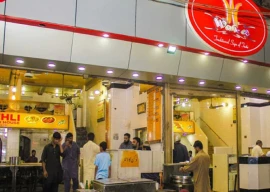
The mouthwatering scent of steaming spices rises up, merges into the chilly air, and soon engulfs the oldest market of the area, Main Bazaar. It doesn’t take long for people to gather around the steaming pot being that is being warmed by liquefied petroleum gas.
At the centre of all the action stands a proud Lala Mustafa, the owner of the only shop that serves the wanted traditional delicacy – harissa. Dramatically, Lala skims the simmering contents with a 36-inch wooden spoon, throws in a few more spices, and finally declares the mutton dish ready.
A family’s flair
As the temperature falls sharply, harissa — the ‘perfect and preferred breakfast’ — draws in crowds from old, urban areas of Madina Market, Khwaja Mohalla and Main Bazaar. According to Lala, no one knows the “real way” to prepare the dish except for a few families from Khwaja Mohalla.
“My father was the harissa master in Muzaffarabad. After his death, I decided to carry the business forward as it is a tradition of Kashmir,” says Lala. “My father migrated from Baramulla in 1947. Harissa is our niche here.”
Lala emphasises how important it is to retain a connections to one’s roots and to keep the traditions of generations past alive.
According to Manzoor Geelani, a former chief justice of Azad Jammu and Kashmir who is also a historian and writer, the dish dates back to the Mughal era. It was later introduced to Kashmir, where its cooking style changed immensely.
“It’s a hard job, but I will do anything to keep the tradition of harissa-making from fading away,” Lala exclaims passionately.
Not an easy task
Due to inflationary pressure, a kilogramme of harissa ends up costing Lala Rs1,000 to prepare. Customers pay Rs100 to Rs150 for a plate, and are served two complimentary naans alongside.
“Due to the rising cost of spices and LPG, the price per plate is actually very economical,” explains Lala. “The hard work that goes into making the dish is also factored in. The preparation of this winter dish needs immense patience.”
Made mostly with lamb shanks, harissa is not an easy delicacy to perfect. Rice must be skimmed down
to a mushy concoction that is later mixed with meat and spices — mostly garlic
and fennel seeds — and is cooked on low flame for six to eight hours.
And yet, for satisfied customers, the effort is worth it.
Shahid Wani, a regular visitor to Lala’s shop, says he has consistently eaten harissa for five winters.
“I enjoy it every weekend,” he says. “It’s delicious and helps me beat the cold.”
Similarly, businessman Khawaja Samad has habitually relished the dish for ten years.
Harissa and health
According to Dr Reyaz Sheikh, a medical practitioner, harissa has double the nutritional value than just mutton alone, particularly when it is eaten early in the morning.
“It’s much better than junk food. It has no preservatives or chemical ingredients,” says Sheikh. “It is a rich source of protein and fat, and also helps rebuilt tissues.”
However, overeating harissa can be counterproductive to health and lead to significant weight gain, warns the doctor.
Published in The Express Tribune, November 15th, 2013.
COMMENTS (2)
Comments are moderated and generally will be posted if they are on-topic and not abusive.
For more information, please see our Comments FAQ
1718870162-0/BeFunky-collage-(60)1718870162-0-405x300.webp)
1730504285-0/Martha-(1)1730504285-0-165x106.webp)





1725446940-0/Untitled-design-(16)1725446940-0-270x192.webp)









Harrisa is really a tasty dish but with the pasage of time it is not being prepared in that way resultantly its taste was compromised which is injustice with this historic kashmiri dish.